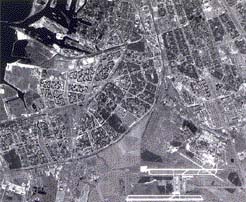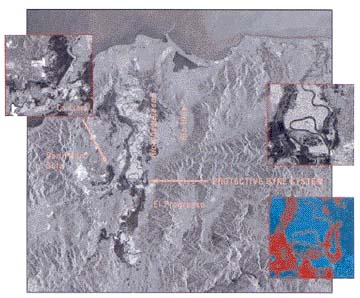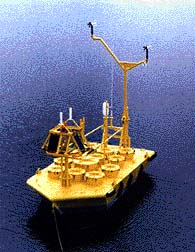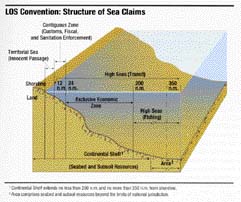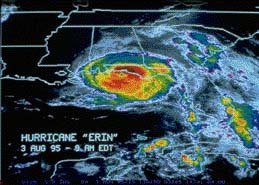b. Cuba
The future of Cuban migration, like everything else in Cuba, is inextricably linked to the future of the government of Fidel Castro. Cuba, because of its poor economy and political repression, will remain a consistent source of illegal immigrants and a mass migration threat as long as the Castro regime stays in power. At any given time, tens of thousands, if not hundreds of thousands, want to leave Cuba. Castro may allow their departure by boatlift at any time he deems it in his best interest, as he did in 1965, 1980, and 1994.17
The likelihood of a mass migration from Cuba will be the greatest following Castro's death or at the beginning of the ensuing political transition period. The stability of the Cuban population during this period will hinge greatly on the method of Castro's departure. Two factors in particular will affect Cuban security and therefore the chance of a mass migration. First, at the present time, there is no successor charismatic enough to keep the Communist Party alive once Castro is gone. Consequently, there could be a power struggle or period of instability following his departure, especially if it is a sudden departure. Second, the stated desire by the Cuban émigré community in the United States to be a part of post-Castro Cuba will exacerbate the instability of any regime change.18 While a mass migration from Cuba will remain a viable threat well into the next decade, the intensity of this threat should decrease by 2020; by that time Cuba should be well past the projected social, economic, and political turmoil of the post-Castro transition period. However, Cuba will likely remain a source of constant illegal migration, akin to the current Dominican migration.
c. Haiti
Illegal migration from Haiti to the United States will encompass two different challenges over the next 20 years. The first is the possibility of a mass migration from Haiti by boat. In the past, political instability and violence have triggered Haiti's mass migrations, and these will likely remain mass migration indicators well into the future. The most recent example was in 1994, when the overthrow of elected President Jean Bertrand Aristide led to the mass exodus of over 25,000 Haitians by boat. The nation's current struggles as a fledgling democracy are just the latest evidence that, politically, nothing seems to change in Haiti. Political instability and ineffective government will probably
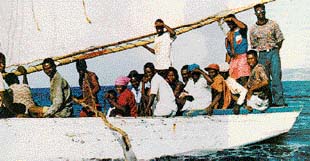
Figure II-3. Haitian migrants.
remain over much of the next 20 years, continuing the environment conducive to periodic mass migrations. Furthermore, there is a substantial risk that organized criminal groups, particularly drug traffickers, will become entrenched in Haiti, bringing more corruption and even more instability to the government. There are already signs of this occurring; cocaine smuggling through Haiti has increased over 50 percent between 1996 and 1998, and intelligence reporting indicates cocaine traffickers may have gained influence within government organizations.19
The second challenge posed by Haiti is the problem of constant migration brought on by the country's miserable economy. Haiti is likely to remain the poorest nation in the Western Hemisphere, with its wealth concentrated in the hands of very few. The country has few natural resources and has been unable to attract much foreign investment because of its instability. Moreover, Haiti's population is projected to increase from under 6 million in 1990 to close to 10 million in 2020, further straining the already moribund economy.

Figure II-4. Population in Haiti.20
As they have in the past, Haitians will surely try to escape their plight by attempting to migrate illegally to the United States. Most of these illegal migration attempts will involve large groups of people moving by boat, since most Haitians do not have the means to migrate by more sophisticated methods involving false documentation and air travel.
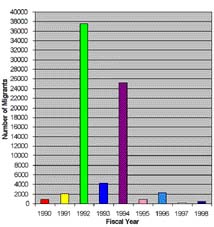
Figure II-5. Haitian Migrants Interdicted at Sea by U.S. Coast Guard,
FY90 - FY 98.
d. Dominican Republic
Migration from the Dominican Republic over the next two decades will take the form of a fairly consistent stream of people moving to the United States either permanently or temporarily for economic reasons. The Dominican economy is more stable and advanced than that of Haiti, but the country's ability to develop beyond a third-world state will be limited by continued internal political corruption and a weak infrastructure. Moreover, between 1990 and 2020, the population in the Dominican Republic is predicted to increase from 7 million to over 11 million people. The combination of a weak economy and a growing population will ensure there is a large pool of people desiring to travel to the United States.
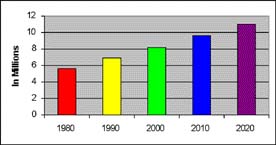
Figure II-6. Population in the Dominican Republic.21
Although Dominicans illegally migrate to the United States by various methods, movement by small boat, or yola, to the U.S. territory of Puerto Rico will remain a primary method. The trip across the Mona Passage to Puerto Rico is only about 60 miles, and once there, Dominicans do not have to clear customs and immigration to get to the United States. Sustained law enforcement pressure by both the Dominican and U.S. governments will be able to curtail, but not eliminate, yola transits in the future. Figure II -7 contains historical information on the interdiction of Dominicans at sea by the U.S. Coast Guard.

Figure II-7. Dominican Migrants Interdicted at Sea by
U.S. Coast Guard, FY 90 - FY 98.
The probability of mass migrations from the Dominican Republic is less than that for Cuba or Haiti, although the possibility will exist through 2020. Political upheaval, violence, or government complicity (as in the case of Cuba) generally trigger mass migrations,22 but violent rebellion or revolution is not a part of the country's recent history. However, governmental corruption and inefficiency are rampant, factors which eventually could lead to greater instability and an increased risk of mass migration. Also, economic migration will fluctuate, and at times may become pronounced, especially with the economy's inability to cope with the large projected population increase.
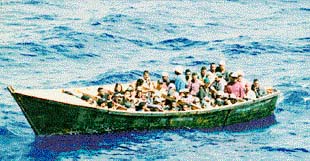
Figure II-8. Dominican migrants in a yola.
e. Mexico
From the migration perspective, Mexico will present the largest challenge to the United States well into the 21st century. Mexico is the single greatest source of both legal and illegal immigrants to the United States,23 and serves as the final transit country for many other U.S. bound illegal migrants. Currently, maritime migration from Mexico is low because the vast majority of migrants cross over the Mexican-U.S. land border. However, maritime migration from Mexico may rise in the future if the United States substantially strengthens customs and immigration enforcement on the land border.
Population growth in Mexico, a U.S. labor market in need of Mexican workers, and the established historical pattern of Mexican migration to the United States will ensure legal and illegal migration of Mexicans to the United States remain a constant phenomenon over the next 20 years. It is impossible to count the number of Mexicans who illegally enter the United States from Mexico, but recent estimates project that illegal migration from Mexico accounts for 55 to 60 percent of unauthorized residents within the United States.24 The Mexican population is estimated to increase from approximately 85 million people in 1990 to over 134 million people by 2020, ensuring there will be strong pressure to migrate to the United States in the future. Furthermore, migration to the United States, either permanent or temporary, has become a way of life for many Mexicans, who can make more money in the United States and even send some of it back to relatives in Mexico.
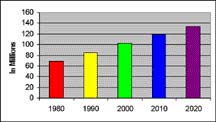
Figure II-9. Population in Mexico.25
Mexico is and will remain a key transit country for U.S.-bound illegal migrants from around the world. The country forms a natural land bridge between the United States and the rest of Latin America, and, with its long coastlines, ineffective law enforcement, and a 2,000-mile land border with the United States, Mexico is an optimal migration gateway to the north. Smugglers of Central Americans and Asians, Chinese in particular, will continue to use Mexico as their entry point to the United States. Thousands of Central Americans annually make the trek through Guatemala into Mexico, and into the United States. In the past few years, Chinese smugglers have begun bringing illegal Chinese migrants by boat into Mexico or Central American countries for further transport overland to the United States. There are no indications that any of this will change in the foreseeable future. In fact, the increase in cross-border trade between Mexico and the United States created by NAFTA will only serve to make Mexico more inviting to smugglers of all types of contraband, including humans.
Though illegal migration from Mexico to the United States by maritime means is currently low, it may well increase in the years ahead should the United States substantially stiffen its land border enforcement. There are periodic reports of small vessels skirting around the Tijuana-San Diego border, carrying illegal migrants into California. This type of activity will increase, both on the Pacific and Gulf coasts, should it become more difficult to cross the land border. Because the United States appears committed to raising the priority of enforcement of its southwest border, as evidenced by recent initiatives to substantially increase the number of U.S. Border Patrol agents, much stronger border enforcement is not unrealistic. Smugglers will adapt; if crossing the land border becomes too risky or unprofitable, they will find new means to move their customers. Maritime transport of larger numbers of people by larger vessels is one logical possibility.
f. Central and South America
As occurs today, many Central and South Americans will attempt to migrate, legally or illegally, to the United States through 2020. The amount of migration will depend on the level of growth of Latin American economies, but, given the anticipated population growth and widening disparity between rich and poor, migration north to the United States will undoubtedly be a desirable option for many. Mass migrations will not likely be a major concern; the challenge of migration from Central and South American states will result from its constancy, not from its peaks.
Because of the success of smuggling illegal migrants overland into the United States, maritime migration will probably not become a great concern. Overland smuggling groups, routes, and methods are well entrenched throughout Central America, and the development of maritime routes and methods is unlikely unless a concerted effort is mounted against overland smuggling. While the United States may mount a stronger effort at its southwest border, there is little prospect for greater enforcement by Central American countries forming the land bridge to the United States. Central American states may make token efforts in response to U.S. pressure, but migrant smuggling is not one of their primary concerns. For most of these states, migration is an important "safety valve" that helps to relieve domestic pressure. Moreover, money sent back to relatives from Latin Americans who have made it to the United States is a significant source of revenue for the economies of these nations. El Salvador estimates that Salvadorans residing in the United States remit $3 billion (U.S.) annually to its economy,26 equaling between a quarter and a third of its gross domestic product.
g. Asia
The population of Asia will increase significantly over the next 20 years, and population growth in already over-crowded states may trigger an increase in migration abroad, including maritime migration to the United States. Asia's population will grow at a slower rate than Africa and Latin America, but it will still retain half of the world's population in 2020. While this lower rate of population growth will enable some Asian countries to adjust to the effects of demographic change, the projected population growth in countries such as China, India, and Pakistan may introduce or accentuate internal pressures for international migration. The key will be whether economic growth can raise the standard of living in these countries enough to offset the lure of migration to nations such as the United States. Strong economic growth will moderate migration pressures.
Over the course of the next 20 years, illegal Asian migration will likely remain a major concern for the United States. Population growth and economic pressures will continue to drive Asians, particularly Chinese, to leave their homelands for the United States. In addition, the expansion of organized alien smuggling operations will provide migrants with multiple channels to the United States.
h. China
Illegal migration from the People's Republic of China has intensified over the past decade and is expected to remain a challenge through 2020. This problem is particularly troubling because of its increasing association with organized smugglers and

|
|
Figure II-10. Chinese migrants interdicted en route
to the United States.
|
international crime syndicates. These criminal groups actively recruit Chinese nationals, promising safe passage to the United States, in exchange for horrendous fees, inhumane transportation conditions, and possible indentured servitude upon arrival. As the population increases in the People's Republic of China, and as China undergoes the painful, but necessary, reform and restructuring of its economy, potential migrants will continue to use every means available to depart their country illegally, including paying smugglers money to be transported to the United States and enduring a 6-month voyage by sea.
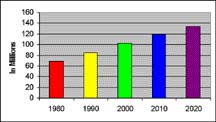
Figure II-11. Population in China.27
i. India and Pakistan
The projected population growth in India and Pakistan will increase internal pressures for international migration, including migration to the United States. While the full extent of illegal migration from India and Pakistan to the United States is presently not known, it does occur and typically involves a combination of land, sea, and air travel. It is believed that the majority of illegal entries are made at U.S. airports using false documentation, but Indian and Pakistani nationals also have been stopped in Latin America, the Bahamas, and the Caribbean while trying to enter the United States illegally by maritime means. Maritime transport will be employed in the future by Indians and Pakistanis trying to illegally migrate to the United States, but will likely remain simply one element of a multi-modal voyage from India or Pakistan. Finally, while the future level of illegal migration from India and Pakistan cannot be identified now, the projected population growth in both countries may create the potential for a migratory challenge similar to that currently presented by China.
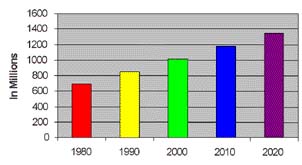
Figure II-12. Population in India.28
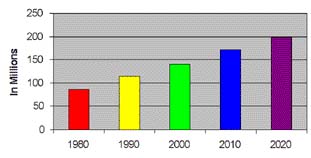
Figure II-13. Population in Pakistan.29
j. Africa
Africa, the fastest growing region in the world, will constitute over 15 percent of the world's population by 2010. In particular, Sub-Saharan Africa will undergo the most significant population explosion, with major population increases in Rwanda, Burundi, Ghana, Malawi, Nigeria, and Uganda. However, the migration of large numbers of Africans by maritime means to the United States has not been a significant problem in the past, and is unlikely to become one for the foreseeable future. Between 1992 and 1998, less than 370 illegal African immigrants a year were interdicted by the U.S. Border Patrol at U.S. borders and ports.30

Figure II-14. Africa's population will expand significantly by 2020.
The maritime movement of Africans, particularly those from the northernmost countries, is generally aimed at the European continent in general and at France and Spain in particular. Over the next two decades, migration is projected to become the single most important issue in relations between the European community and Arab states of Africa.31 For Africans, Europe is a closer refuge, while there is no historical precedent for major voluntary migrations of Africans to the United States.
Although Africans account for some 48 percent of the world's displaced persons, mass migrations by maritime means to the United States or other countries have not yet occurred and are unlikely to occur in the future.32 African mass migrations have largely been, and will continue to be, an intra-continental and temporary solution to economic strife, ethnic warfare, or epidemics. Additionally, when such migration occurs, it primarily takes place overland on foot or by vehicle.
3. Non-state Actors
By 2020, non-state actors will challenge the sovereignty of the state and have a greater effect on international affairs. While the state will still play the predominant role in the international political system, national and international security will be affected by the interactions between state and non-state actors, owing to the inclusion of a greater number of players in international affairs and the development of alternative forums for grievances and action.33
Non-state actors can be separated into two categories, civil actors and non-civil actors. Civil actors are defined as non-state groups whose actions complement the values of the international community and its state members. Non-civil actors are those groups whose actions defy the values of the international community and its members. Both types of non-state actors pose transnational challenges to individual states insofar as they have the ability to "undermine law and order, and create disaffection and alternate loyalties. Over the long term, they create conditions conducive to instability and conflict."34 Consequently, the potential exists for non-state actors to decisively affect global conditions by causing governments to lose some measure of control and inhibiting their ability to deliver solutions to their citizens' problems.35
a. Civil Actors
The ever-growing importance of civil actors in the international arena is a trend that will continue through 2020. While the objectives of individual civil actors may contradict or challenge the goals of the states in which they operate, the civil actors and the state peaceably work to resolve their differences in the interest of promoting the greater good. The media, multinational corporations, and non-governmental organizations constitute the three major types of non-state civil actors. All three will be able to exert a greater impact on international relations because they have access to resources governments cannot harness and because they often are able to rally international opinion more easily. For example, the media controls what is essentially an extensive intelligence collection capability, and can use the information it gathers to influence its audience and affect policy decisions at the local, national, and international levels. Multinational corporations can have extraordinary influence on local or even national economies, and thereby affect the underlying security of a state. For example, cruise lines, some of which have operating budgets larger than the combined national budgets of several eastern Caribbean states, can greatly affect the economic well-being and thus security of many small states by their decisions on ports of call.36 Finally, non-governmental organizations can be very effective at advancing their agendas in international forums by mobilizing their constituencies and skillfully pressuring government policymakers, as well as by organizing collective action in response to crises, providing forums for negotiations to mitigate crises, and monitoring post-crisis agreements.
(1) Environmental Activist Groups. One particular type of non-state civil actor that may have great impact in the maritime sphere through 2020 is the environmental activist group. With growing concern about the rising stress on the environment created by population growth and increasing development, environmental groups will likely gain in number and influence. Groups such as Greenpeace already have a large support base of contributors, and carry out operations across the globe.
The marine environment will be of great concern to environmental groups in 2020, with living and non-living marine resource exploitation the primary focus. These groups will not only try to influence public opinion and government policies through media campaigns, but also by taking direct action on the seas, demonstrating against operations they oppose. While most of these demonstrations will be non-violent, the possibility exists for violence to break out when opposing groups come in contact, and conflict in the maritime environment is doubly dangerous for the safety of life and property. Furthermore, some groups may advocate taking aggressive measures to push their causes. There have already been incidents of violence involving environmental activist groups, such as the ramming of whaling vessels by ships belonging to the militant Sea Shepherd Conservation Society.
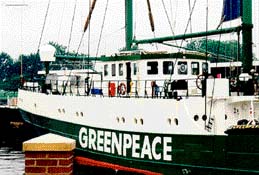
|
|
Figure II-15. One of six vessels operated
by the environmental group Greenpeace.
|
Future operations by environmental groups will likely increase in complexity and scope. Greenpeace already has a six-ship fleet it uses to carry on its activities worldwide, and in 1998 demonstrated the ability to locate and board a ship on a sensitive mission carrying nuclear waste from France to Japan. Greenpeace also conducted operations in 1998 featuring deception, with their activists posing as security personnel or government inspectors. Success in these operations, particularly if accompanied by media attention, will spur attempts at larger and even more intricate operations aimed at garnering big headlines to further environmentalist causes.
An emerging development that may become a source of considerable conflict in 2020 is the diverging interests between environmental groups and native peoples. As native peoples around the world attempt to continue or reestablish customary practices deemed harmful to the environment by activist groups, disagreements and outright hostility may arise. For example, in 1997 the International Whaling Commission (IWC) authorized subsistence hunting of gray whales by the Makah Indian tribe in Washington state and the Chukotka people in Russia. These two peoples claimed that gray whale hunting was a part of their culture; in fact, the Makah cited an 1855 treaty granting its whaling rights. The IWC established a 5-year block quota of 620 gray whales. The plan by the Makah tribe to renew hunting whales is vigorously opposed by environmental groups, especially the Sea Shepherd Conservation Society, which has threatened to disrupt any whale hunt by the Makah. Potential conflicts such as these will likely increase in the future as environmental groups rise in influence and oppose native claims.
b. Non-civil Actors
Non-state non-civil actors such as organized criminal groups and terrorists will continue to pose a constant challenge to the security of nations and international organizations through 2020. In contrast to civil actors, non-civil actors will not attempt to resolve their differences peacefully within the international system or with individual states. Rather, non-civil actors may use violence or intimidation to oppose the states in which they operate and the international system.
(1) Organized Crime. Organized crime will increase in influence and scope over the next 20 years as organized criminal groups become increasingly entrenched in the international economy and as demand for and profits from the illicit transportation of people, drugs, and contraband multiply. If left unchecked, international criminal organizations will continue to expand their illegal activities in the 21st century. International criminal organizations will increase in number and influence as they become more adept at manipulating and challenging local and national governments and international organizations and consolidating their power bases.37 The expected growth of transnational criminal organizations will be exacerbated by advances in communications and transportation technologies; a decrease in governmental controls over the international flow of goods, services, and money; the establishment of international affiliations among immigrant communities; and the projected rates of unemployment in developing countries and in the Soviet successor countries and Eastern Europe. Relying on a myriad of international connections to provide them with both human and financial resources, by 2020 transnational criminal syndicates will be as problematic for global security as organized insurgent groups and terrorists.
According to Dr. Kimberly Thachuk, an organized crime expert,
"International organized crime is more than simply an extension of domestic crime. It is crime ordered into complex clandestine, hierarchically-organized networks, that operate internationally with little regard for the borders of states. The gravity of the problem lies not only in the increasing complexity of these organizations, but more importantly, with the serious challenge they pose in their ability to penetrate and operate with relative impunity in several states simultaneously. These illegal enterprises not only threaten aspects of state sovereignty and security that have traditionally been taken for granted, but they prove the permeability of national borders and the vulnerability of state institutions."38
Criminal organizations will continue to attempt to deceive law enforcement authorities by integrating legal and illegal operations. For example, Chinese triads (organized criminal groups) involved in heroin and maritime alien smuggling set up legitimate businesses in the United States that are used to channel money from their smuggling ventures. Organized crime also will continue to develop business strategies similar to those used by legitimate corporations. The application of these business practices will enable transnational criminal groups to increase the efficiency and profit margins of their operations.39
Transnational criminal organizations can not only adversely affect civil society, but they can also threaten the power and sovereignty of the states in which they operate. The willingness of transnational criminal organizations "to use force against the state and its law enforcement agencies, challenges the state monopoly on organi[z]ed violence and can be more destabilizing than the activities of revolutionary or terrorist groups."40 For example, the Russian Mafia has influenced and corrupted national banking systems, commodity markets, and internal security systems, areas that normally fall solely under the purview and authority of the state and its official agents. In Latin America and the Caribbean,
"The problem of corruption, in which formal political organizations are steadily undermined in their capacity to operate efficiently, cannot be overstated. . . Where organized crime has made a significant inroad, as in Mexico, Colombia, Jamaica, Haiti, and Bolivia, corruption has so undermined legitimacy that these states have at times been unable to guarantee even the most basic order for their citizens."41
Over the next 20 years, Russian crime syndicates, Latin and South American drug cartels, and Asian triads and ethnic gangs will continue to vie with one another for regional superiority and the control of illicit activities. All of these criminal organizations possess and will continue to possess the ability to threaten weak states in Eastern Europe, Asia, and Latin America through alliances forged with insurgent groups (e.g., the FARC in Colombia) and by the corruption of police, military, or political authorities.42
The end of the Cold War and the opening of Eastern Europe, Russia, and the other Soviet successor countries have brought to light the significant role played by large organized groups in international crime. For example, drug trafficking organizations, seeking to diversify, have extended their connections with criminal groups abroad to expand their operations in both Eastern and Western Europe. The European organized crime groups not only have capitalized on these international connections, but also have seized the market opportunities made available in Eastern Europe and the Soviet successor states by the collapse of the Warsaw Pact and the Soviet Union.
Developing states, Eastern European countries, and the Soviet successor states will be particularly susceptible to the perverse influence of transnational organized crime and will remain susceptible well into the 21st century. Over 8,000 criminal enterprises operate in the 15 countries that succeeded the Soviet Union and at least 200 of those organizations are international in scope.43 In the absence of effective governments and the ability to enforce national and international laws, transnational crime will thrive and could hamper or even cripple the ability of some states to effectively manage their society and even their sovereignty. The growing influence of international organized crime is even felt in developed nations such as the United States. For example, the Chinese triads, which illegally move Chinese nationals to the United States, have almost single-handedly brought the practice of indentured servitude back to the United States.
International organized crime is involved in a wide variety of criminal enterprises, of which the highly visible drug and arms trafficking activities are only a part. Maritime alien smuggling from Asia and the Caribbean to the United States has become a growth industry for large- and small-scale organized criminal groups. Most international organized crime groups are also involved in fraud, cargo theft, the acquisition and sale of precursor chemicals for both drug production and weapons of mass destruction, extortion, etc. The decline in importance of state borders to international business has the negative collateral effect of facilitating the free movement of organized crime operations across national borders and will continue to enable organized crime groups to exert their power globally.
(2) Violent Maritime Crime. Incidents of violent maritime crime will probably not significantly change either in nature or frequency out to and beyond 2020. Consistent with current experience, the vast majority of incidents will occur within port areas, at anchor or in coastal waters. The primary forms of violent maritime crime are piracy and terrorism.
(a) Piracy. While the number of piracy incidents will most likely remain constant over the next 20 years, there will be an increase in incident reporting. It is widely accepted among the government and non-government organizations that track piracy
worldwide (including the U.S. Office of Naval Intelligence (ONI), U.K. Defense Intelligence Service (DIS), Australian Defence Intelligence Organization (DIO) and the International Maritime Bureau (IMB)), that the annual number of piracy cases is seriously undercounted. DIS estimates the actual number of piracy cases could be 2,000 percent higher on an annual basis while DIO estimates the
|
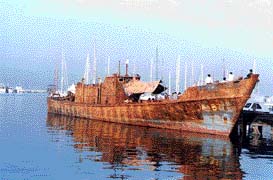
|
|
Figure II-16.
Chinese pirate vessel. |
underreporting to be 20 to 70 percent.44 Since the establishment of the IMB's Regional Piracy Center in Malaysia in 1992 and its subsequent efforts to publicize the piracy problem, there has been increased reporting on major incidents (See Figure II-10), but incidents involving fishermen and recreational boaters are still heavily undercounted. Also, the average loss from a piracy incident does not cross the monetary threshold for insurance action, further contributing to underreporting.45 Most incidents will continue to go unreported except in cases where there is serious loss of property and life or damage to a foreign interest.

Figure II-17. World Maritime Piracy Incidents.46
The concentration of piracy incidents will continue to be located in areas with little or no maritime law enforcement, political and economic stability, and a high volume of commercial activity. Incidents of piracy tend to occur in four regional areas: Southeast Asia, Africa, South America, and Central America (see Table II-3). Furthermore, most incidents of maritime crime occur in coastal waters with nearly 80 percent of all reported piracy incidents occurring in territorial waters (See Table II-4).
|
AREA |
TYPICAL TARGETS |
CAUSE |
|
Caribbean |
Pleasure Craft,
Small Merchant Ships |
Common Crime, Lack of Government Attention |
|
Central America |
Fishing Boats |
Common Crime, Lack of Government Attention |
|
South America |
Merchant Ships,
Fishing Boats |
Common Crime, Lack of Government Attention |
|
West Africa |
Merchant Ships,
Oil Industry |
Common Crime, Poor Security Environment |
|
East Africa |
Merchant Ships |
Traditional Culture, Common Crime, Poor Security Environment |
|
SE Asia |
Merchant Ships,
Fishing Boats |
Organized Crime, Common
Crime, Traditional Culture,
Poor Security Environment |
|
East Asia |
Merchant Ships |
Organized Crime, Common
Crime, Traditional Culture,
Poor Security Environment |
Table II-3. Piracy Prone Areas.47
|
GEOGRAPHIC
AREA |
INCIDENTS AT
ANCHORAGES/BERTHS
(%) |
INCIDENTS WHILE UNDERWAY
(%) |
|
Worldwide |
79 |
21 |
|
Africa |
71 |
29 |
|
Far East |
70 |
30 |
|
Americans |
95 |
5 |
Table II-4. Location of Pirate Victims.48

|
|
Figure II-18. Law
enforcement personnel developing
counter-terrorist exercises.
|
Piracy in the 1990s against commercial shipping reveals increasing violence and professioal organization. A dangerous trend is the emergence of organized pirate gangs, which may conduct multi-ship operations, and/or use tactics of a quasi-military nature.49 These gangs may acquire the capability to target ships on the open ocean thus increasing the potential number of piracy victims. Of greater concern to the shipping industry is the level of violence used during attacks. The criminals carrying out pirate attacks often display a complete lack of concern for the victimized crews, who are at risk of being severely wounded, killed, or set adrift.50 The 1998 hijacking cases of the CHEUNG SON and TENYU in Southeast Asia illustrate the use of violence by pirates. In both cases, the crews were missing and presumed dead (21 total) after the ships were recovered from pirates.
(b) Maritime Terrorism. Future terrorist organizations will continue to use attacks on maritime targets as a means of furthering their political goals. From the 1961 hijacking of the Portuguese flagged passenger vessel SANTA MARIA to the numerous maritime attacks of the Sri Lankan Tamil Sea Tigers during the 1990s, widely publicized incidents of terrorism in the maritime environment have drawn immediate concern and action. There has been a marked tendency when discussing maritime terrorism to address it as an approaching trend and as a phenomenon somehow different from, and possibly greater than, the broader problem of terrorism. This is particularly true whenever some incident grabs the public attention through extensive media coverage. But of maritime terrorism shows that it is not new and that it differs little, if at all, from terrorism ashore or, for that matter, in the skies. In fact, maritime terrorism occurs in the same forms and methods as acts perpetrated ashore.51
Trends seen in terrorism during the late 1980s and 1990s will likely continue in the future. The number of terrorist incidents worldwide has decreased while the number of casualties inflicted has risen. The typical terrorist tactic of holding hostages has declined, due in part to the growing sophistication of counter-terrorist forces worldwide.52 Also, the number of terrorist groups espousing a leftist ideology such as Marxism and Socialism has decreased, with a subsequent rise in the number of groups based on nationalism, ethnicity and religion.
While terrorists would prefer to attack a target that is immobile and easy to survey, there will continue to be a small number of attacks in the maritime environment.53 For example, several Middle Eastern terrorist groups maintain a maritime attack capability through diver and underwater warfare training provided by Iran and Libya.54 Other groups with a cultural maritime heritage find it easier to develop a competent maritime attack capability. The Sri Lankan Tamil Sea Tigers and the Filipino Abu Sayyang Group are examples of seafaring groups that have conducted multiple maritime terrorist attacks, as well as piracy acts for fundraising purposes. The concern for the future is that terrorists will shift emphasis and make the rapidly growing cruise line industry a new target of opportunity.
Major financial loss, significant loss of life, or widespread publicity surrounding environmental damage caused by violent maritime crime will increase pressure upon coastal states to coordinate maritime law enforcement actions. U.S.-Cuba anti-hijacking agreements and anti-pirate agreements between Malaysia, Indonesia, and Singapore may prove to be forerunners of many such accords that will attack the centers of maritime crime.55 However, international law enforcement coordination will be successful only if it can overcome exaggerated pride, self-sufficiency, and sovereignty concerns of many developing coastal states. Confusion over the proper legal definition of piracy is itself hindering potential international cooperation; the UN definition is concerned with international waters while the shipping industry definition covers all waters (See Text Box). This lack of a common definition slows down the creation of international agreements designed to combat piracy.


















